Winter 2020 Newsletter
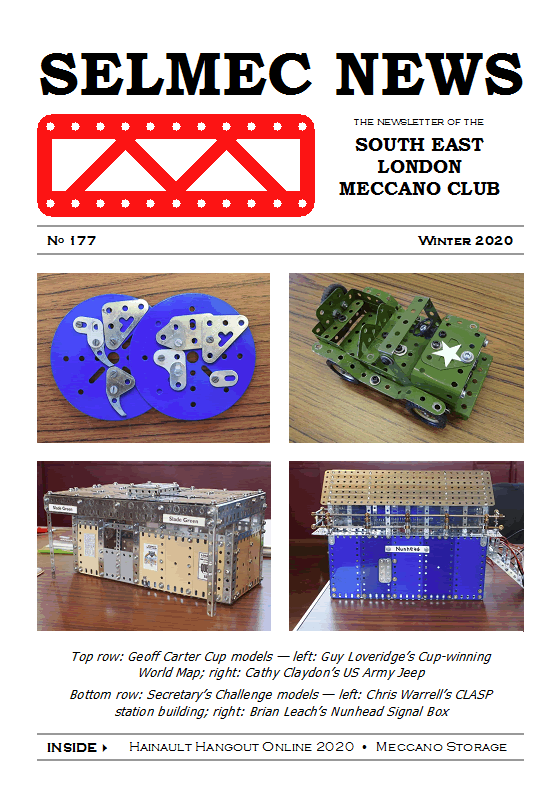
Winter 2020 Newsletter
Issue 177
This was one of our informal quarterly meetings where our members showed off their latest Meccano creations.
At around 2:00pm we had our annual general meeting, followed by the Model Tour in which members were invited to give a short talk about their models — in particular their entries for the Secretary’s Challenge!
Report written by Tim Surtell
With both the North and South East London Meccano Club exhibitions cancelled due to the coronavirus pandemic, the clubs decided to team up to take the NELMC Hainault Hangout online.
Twelve club members met online via Google Meet: Les Chatfield, Greg Clarke, Alan Esplen, Brian Leach, Paul Leech, Roger Little, Richard Marsden, Santiago Plicio, Frank Pycroft, Chris Warrell, Alan Wenbourne and me.
The Hangout was open to everyone, so four guests from all over the world joined in too: Tim Gant (Hampshire), Andrew Jardine (Ohio), David Parrott (Switzerland) and Richard Payne (Kent).
Andrew Couzens and Brian Elvidge were unable to ‘attend’ the Hangout, but sent in photos and videos of their models for presentation.
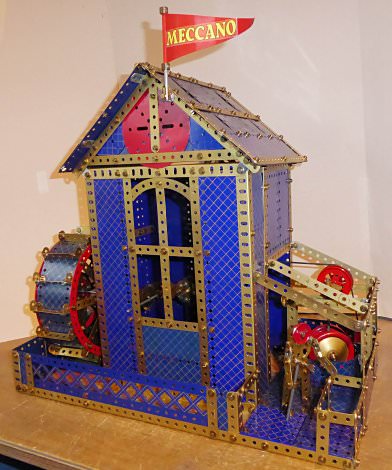
Watermill by Alan Esplen
We managed to run one of our usual ‘guess the number of parts in the model’ competitions — Chris Warrell’s Heath Robinson Christmas Pudding Stirring contraption was the subject, comprising 343 parts. David Parrott won with the closest guess (350), and was so surprised that he later signed up as a member of NELMC ‘in the spirit of fairness and supporting my fellow spanners!’
There were the usual technical problems with video dropping out quite frequently, and dogs and cats making themselves heard, but we spent around two and a half hours discussing each other’s models and demonstrating them live where possible.
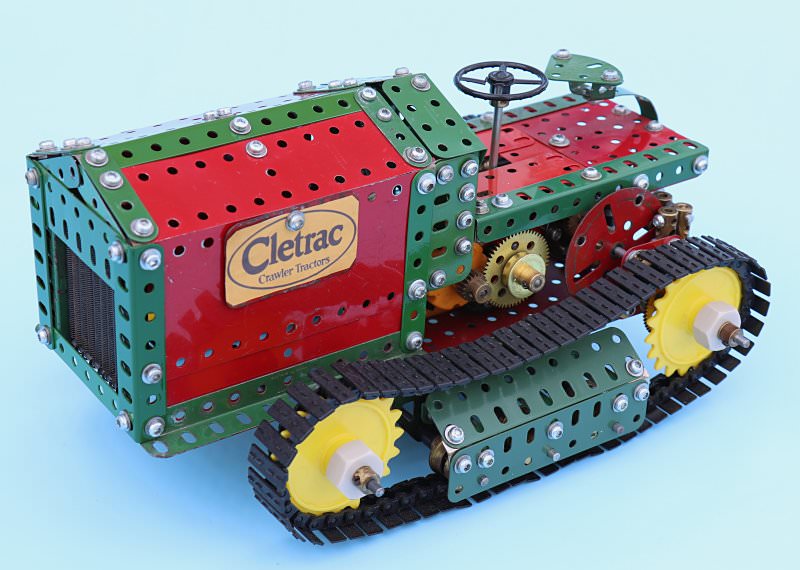
Cletrac tractor by Alan Wenbourne
I had several appreciative e-mails from attendees hoping we could do something similar again in the future — while this is highly likely, I have also been considering live-steaming our real-life meetings (when we return to them) so that members not present can watch online. To gauge demand, if you are interested in this please do let me know.
You can see more photos from the Hangout at the North East London Meccano Club website.
Written by Alan Wenbourne
Having spent something over seventy years collecting and modelling with Meccano, I decided it was time to do something about my storage system. It has become much more tiring having to grovel on the floor, open too many cupboard doors and move boxes and other things out of the way in order to access a particular storage box or container.
Like most Meccano enthusiasts I started with the original cardboard boxes, and then added other various types of cardboard box, metal tins, wooden trays and drawer systems, plastic drawers and compartmental trays with and without lids, until now, where there are just too many different arrangements. The latest system included two multi-drawer wooden cabinets and a range of plastic lidded compartmental boxes which although quite well organised, required too much stooping, heaving and shuffling around to be ergonomic.
I had for some time given the multi-drawer metal filing cabinets some consideration because I was aware of the flip chart systems from early years of employment. These have the advantage of having many shallow drawers that would be ideal for strips, girders and plates etc. An Internet search and contact with second-hand office furniture suppliers drew a blank on this style of cabinet. However, it did reveal the existence of the metal multi-drawer A4 storage systems. These have the advantage of the drawers being 2” deep, allowing much more capacity per drawer. My local used office equipment supplier had no stock but suggested that if he had, he would probably not be very price competitive with Internet suppliers. So, the search widened and I was attracted to the Bisley range which included 15 and 10 drawer units in various colours. I chose to purchase a 15 drawer unit in two colours that would best complement the decor of my model room. The drawers of this unit could be divided into quarters by inserting half-litre microwave/freezer plastic boxes, so a pack of 50 was ordered. The drawers are 14½” long, so perfect for all parts up to 12½”.
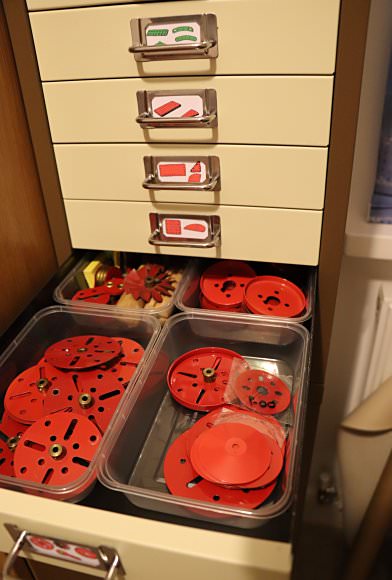
Compartments in the filing cabinet
Other drawers were compartmentalised using the smaller, 2” high, drawers from plastic drawer type storage boxes that I had but which were now redundant.
The photo below shows the cabinet alongside my modelling table with some of the small parts trays and the window blind printed with my London Eye. Each drawer has a label frame at the front and the cabinet comes with a sheet of blank labels.
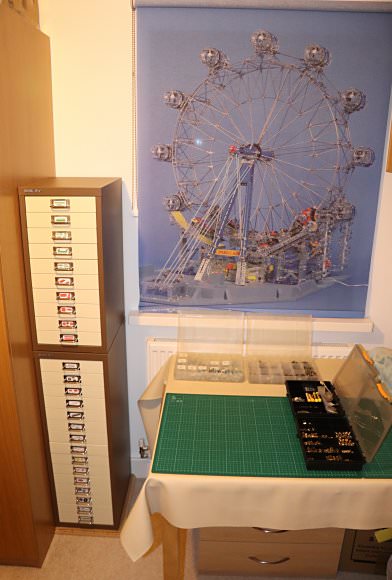
The filing cabinet in Alan’s Meccano room
I decided to avoid part descriptions and numbers in favour of images of the parts contained within each drawer. For this I copied parts lists and contents lists from various set manuals into my PC for further processing to the labelling system. An A4 label sheet was configured with a chart to provide multiple boxes, sized to fit the label frames, into which JPEG images of the parts could be inserted.
Using my photo editing software, the required images were cropped from the parts lists, coloured to suit the parts (i.e. mostly red, green and zinc) and these added to a file for copying and resizing onto the label sheet.
Obviously not every part is depicted on the labels, only those required to indicate the general or typical contents of each drawer.
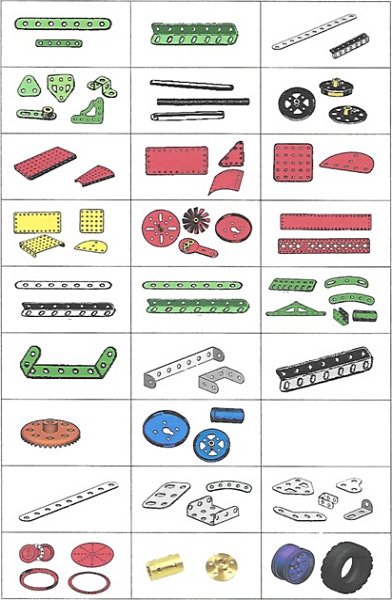
Label sheet
This exercise was so pleasing and successful that I then purchased another 10 drawer unit to complete my Meccano storage system. However, I became concerned over the floor loading as these cabinets were of some considerable weight! I expected the base of the cabinets to be flanged but on examination their edges are folded metal, which presented the carpet with rather sharp edges. So I cut a baseplate from 1” thick MDF which distributed the load over the floor/carpet, and routed the two exposed edges to improve the appearance.
I can now sit at my model table and reach for any part without leaving my chair! All small parts such as nut, bolts, washers and brassware etc. are still in the lidded plastic compartmental cases as before.
Larger and longer parts such as 24½” Strips, Angle Girders, Boilers etc. are still kept in the bigger wooden drawer cabinet.
This is not an inexpensive solution (£250) but then Meccano is not cheap, and as I don’t play golf, it was a worthwhile investment for future model making.